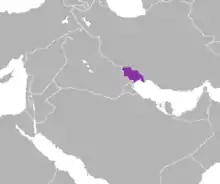Khuzestani Arabic
Khuzestani Arabic is a dialect of Gelet (Southern) Mesopotamian Arabic spoken by the Iranian Arabs in Khuzestan Province of Iran. It is also considered by most contemporary scholars to be a mix of Southern Mesopotamian Arabic and Gulf Arabic spoken in places such as Kuwait and Eastern Arabia. It has had a long history of contact with Persian language, leading to several changes.[1] The main changes are in word order, noun–noun and noun–adjective attribution constructions, definiteness marking, complement clauses, and discourse markers and connectors.[1][2]
| Khuzestani Arabic | |
|---|---|
| Native to | Iran |
Afro-Asiatic
| |
| Arabic alphabet | |
| Language codes | |
| ISO 639-3 | – |
| Glottolog | None |
 | |
Khuzestani Arabic is only used in informal situations. It is not taught in school, not even as an optional course, although Modern Standard Arabic is taught.[1]
Phonology
Consonants
Even in the most formal of conventions, pronunciation depends upon a speaker's background.[3] Nevertheless, the number and phonetic character of most of the 28 consonants has a broad degree of regularity among Arabic-speaking regions. Note that Arabic is particularly rich in uvular, pharyngeal, and pharyngealized ("emphatic") sounds. The emphatic coronals (/sˤ/, /dˤ/, /tˤ/, and /ðˤ/) cause assimilation of emphasis to adjacent non-emphatic coronal consonants. The phonemes /p/ ⟨پ⟩ and /v/ ⟨ڤ⟩ (not used by all speakers) are only occasionally considered to be part of the phonemic inventory, as they exist only in foreign words and they can be pronounced as /b/ ⟨ب⟩ and /f/ ⟨ف⟩ respectively depending on the speaker.[4][5]
| Labial | Dental | Denti-alveolar | Palatal | Velar | Uvular | Pharyngeal | Glottal | |||
|---|---|---|---|---|---|---|---|---|---|---|
| plain | emphatic1 | |||||||||
| Nasal | m | n | ||||||||
| Stop | voiceless | (p) | t | tˤ | k | ʔ | ||||
| voiced | b | d | dˤ | g | ||||||
| Fricative | voiceless | f | θ | s | sˤ | ʃ | x ~ χ | ħ | h | |
| voiced | (v) | ð | z | ðˤ | ɣ ~ ʁ | ʕ | ||||
| Affricate | voiceless | tʃ | ||||||||
| voiced | d͡ʒ | |||||||||
| Tap | ɾ | |||||||||
| Approximant | l | (ɫ) | j | w | ||||||
Phonetic notes:
See also
References
- Khuzestani Arabic: a case of convergence
- Shabibi, Maryam (2006). Contact-induced grammatical changes in Khuzestani arabic (PhD thesis). University of Manchester. EThOS uk.bl.ethos.529368.
- Holes (2004:58)
- Teach Yourself Arabic, by Jack Smart (Author), Frances Altorfer (Author)
- Hans Wehr, Dictionary of Modern Written Arabic (transl. of Arabisches Wörterbuch für die Schriftsprache der Gegenwart, 1952)